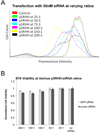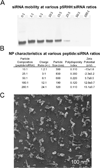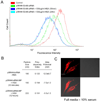Melittin derived peptides for nanoparticle based siRNA transfection
- PMID: 23380356
- PMCID: PMC3578292
- DOI: 10.1016/j.biomaterials.2013.01.037
Melittin derived peptides for nanoparticle based siRNA transfection
Abstract
Traditional transfection agents including cationic lipids and polymers have high efficiency but cause cytotoxicity. While cell penetrating peptide based transfection agents exhibit improved cytotoxicity profiles, they do not have the efficiency of existing lipidic agents due to endosomal trapping. As a consequence, we propose an alternative method to efficient peptide based siRNA transfection by starting with melittin, a known pore-forming peptide. By incorporating modifications to decrease cytotoxicity and improve siRNA binding, we have developed p5RHH, which can complex siRNA to form nanoparticles of 190 nm in diameter. p5RHH exhibits high efficiency with GFP knockdown at concentrations as low as 5 nM, with negligible cytotoxicity. To date, p5RHH has shown the ability to transfect B16 cells, Human Umbilical Vein Endothelial Cells, and RAW264.7 cells with high efficiency. These in vitro models demonstrate that p5RHH mediated transfection can block cancer cell proliferation, angiogenesis, and foam cell formation. Moreover, p5RHH/siRNA nanoparticles maintain their size and transfection efficiency in the presence of serum proteins suggesting the potential for use of p5RHH in vivo. These data suggest that our strategy for development of siRNA transfecting peptides can provide an avenue to safe and effective siRNA therapeutics.
Copyright © 2013 Elsevier Ltd. All rights reserved.
Figures








References
-
- Fire A, Xu S, Montgomery MK, Kostas SA, Driver SE, Mello CC. Potent and specific genetic interference by double-stranded RNA in caenorhabditis elegans. Nature. 1998;391:806–811. - PubMed
-
- Elbashir SM, Harborth J, Lendeckel W, Yalcin A, Weber K, Tuschl T. Duplexes of 21-nucleotide RNAs mediate RNA interference in cultured mammalian cells. Nature. 2001;411:494–498. - PubMed
Publication types
MeSH terms
Substances
Grants and funding
LinkOut - more resources
Full Text Sources
Other Literature Sources
Research Materials

